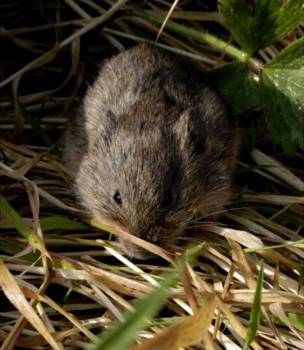Early farmers had already brought the field vole to the Orkney Islands north of Scotland 5100 years ago by boat, most likely from the coast of today’s Belgium, and so maintained the genetic diversity that disappeared from Europe. These conclusions highlight research of an international team of scientists led by the University of Aberdeen (United Kingdom) and Cornell University (USA), which was published on Tuesday, 3 September 2013 in a major professional journal Molecular Ecology (see the abstract). Also researchers from the Institute of Vertebrate Biology of the Academy of Sciences of the CR were involved in one of the most extensive studies of its type.
The scientists used a combination of modern and ancient DNA along with new morphological
techniques for the research of the enigmatic Orkney vole. This model helped to resolve a
long-lasting discussion on the possible European origin of the world-renowned Neolithic culture on
the Orkney Islands.
Orkney vole
Professor Keith Dobney, one of the leaders of the research, explains: “The Orkney vole is one
of the subspecies of the European field vole. They do not appear anywhere else in Britain except
the Orkney Archipelago. The extensive archaeological finds from the Orkneys have already provided
thousands of bones and teeth from residences and grave at least 5,000 years old. That indicates
that voles apparently arrived on boats with early farmers during Neolithic trade and exchange
journeys. For decades, it was a mystery where in Continental Europe they had arrived from and when
exactly that had happened. New genetic techniques and direct dating of the bones have, however,
allowed us to answer these questions.”
Dr. Natália Martínková from the Institute of Vertebrate Biology of the Academy of Sciences,
who worked on the genetic research of the modern voles from Continental Europe and the Orkneys,
says: “Our comparison of genetic diversity showed that throughout continental Europe today there is
no population identical to the Orkney vole. The most similar voles come from the coast of Belgium,
where we expect the original home of Orkney voles.”
The ceremonial stones of the Ring of Brodgar on the Orkneys.
The research, nonetheless, showed also an absolutely unexpected result – the genetic diversity
in all of western Continental Europe is much less than the diversity of the current populace on
Orkney Islands. “It is precisely the opposite of what we would expect in a traditional model of the
colonization of islands and their evolutionary history,” says Professor Jeremy Searle, one of the
leaders of the project from Cornell University. “This discovery shows that we have apparently found
on the Orkneys a genetic moment of the original diversity of the field voles, which existed in
Europe in prehistory. A diversity that subsequently disappeared from the continent but has been
preserved in isolation on the Orkneys.”
The analysis of ancient DNA from Orkney voles (research conducted by Dr. Ross Barnett)
supports the likely origin from the coast of Belgium and confirms that the genetic diversity that
we observe on the Orkneys today was present already in the first archaeological samples found on
the islands, which are more than 5,000 years old. Finally, a two-dimensional analysis of the shape
of the first molars (which was performed by Dr. Thomas Cucchi) showed a rapid and distinctive
evolution of the morphology on the islands from their introduction to the present.
This new research supports the fact that field voles were introduced to the Orkney Islands
soon after the arrival of the first Neolithic farmers and apparently were picked up from the coast
of Belgium and transported directly to the Orkneys. Why the field voles were unable to be
introduced also to the British mainland or other British islands remains a mystery. Our data,
however, shows a direct link of the Neolithic cultures between Continental Europe and the Orkney
Islands.
The much greater genetic diversity of the modern and ancient Orkney voles indicates that the
contact with Europe was intensive. Neolithic seafarers either brought a large number of voles with
them at one time or repeatedly brought individuals from various populations from Continental
Europe. It shows that the Orkney voles are apparently more unique that was thought, because the
current population has preserved several genetic lines that existed in Continental Europe at the
end of the last ice age. This diversity, however, has disappeared on the continent over the last
5,000 years, perhaps because of dramatic population cycles that are especially intensive when
people change the environment. The Orkney voles thus are a genetic ark, preserving genetic
material, which would otherwise have been lost.
The international team included scientists from the Academy of Sciences of the CR, University
of York (UK), University of Aberdeen (UK), Cornell University (USA), Durham University (UK), Hull
York Medical School (HYMS, UK), Oxford University (UK), National Museum of Natural History in Paris
(France), University of Bern (Switzerland), INRA (France), Swiss Institute of Bioinformatics
(Switzerland), University of London (UK) and University of Sydney (Australia).
The research was supported financially by the Marie Curie Intra European Fellowship, Arts and
Humanities Research Council (project grant 119396); the Swiss National Science Foundation (projects
3100A0-112072 and 3100- 126074) SYNTHESYS2 made available by the European Community Research
Infrastructure under FP7 (‘Synthesis of Systematic Resources’, 226506-CPCSA-Infra) and a Wellcome
Trust University award (GR071037) from the Arts and Humanities Research Council.
Source:
Martínková et al.
Divergent evolutionary processes associated with colonization of offshore islands. Published
in the journal, Molecular Ecology, 3 September 2013. DOI:10.1111/mec.12462
Contact:
Dr. Natália Martínková, Institute of Vertebrate Biology of the Academy of Sciences of the CR,
e-mail: martinkova@ivb.cz, mobile phone: +420 606 124 586
Photo: Stanislav Martínek
Illustration: Jan Hošek
Prepared by: The Institute of Vertebrate Biology of the ASCR and the Department of Media
Communication of the Head Office of the ASCR
4 Sep 2013











